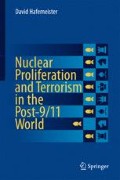Abstract
Every military weapon, it seems, has an anti-weapon defense. Swords versus shields; tanks versus tank traps, poison gas versus gas masks; and so on. Anti-ballistic missile (ABM) defensive weapons are important for several reasons. The connection between offensive missiles and defensive technologies played a role in the nuclear-weapons debate with the former Soviet Union. As long as the US has some ABM prowess, Russia has been less cooperative on strategic arms treaties. The US spends considerable funds, some $10 billion per year on ABM research and deployment.
… to make nuclear weapons impotent and obsolete.
[President Ronald Reagan, March 23, 1983]
“Then we can gang up twenty of them, and we can send out 100-mJ pulse, 20 times per second, and hit any target we want. The impact energy then will be on the order of 20–30 kg of explosives.”
“And that will kill any missile anybody can make.”
“Yes sir.” Major Gregory smiled.
“What you’re telling me is, the thing––tea clipper––works.”
“We validated the system architecture,” the general corrected Ryan. “It’s been a long haul since we started looking at this system. Five years ago there were eleven hurdles. There are three technical hurdles left. Five years from now there won’t be any. Then we can start building it.”
“The strategic implications…” Ryan said, and stopped. “Jesus.”
“It’s going to change the world,” the General agreed.
[Tom Clancy, The Cardinal of the Kremlin, 1989]
Access this chapter
Tax calculation will be finalised at checkout
Purchases are for personal use only
Notes
- 1.
D. Hafemeister, “Review of Star Wars Enigma” by N. Hey, J. Cold War Studies 10(2), 141–143 (2008).
- 2.
Wilkening (2012).
Bibliography
American Physical Society. (1987). Science and technology of directed energy weapons. Review of Modern Physics 59, S1–S202 and Physics Today 40(3), S1–16.
American Physical Society. (2003). Boost-phase intercept systems for national missile defense. College Park, MD: APS.
Bridger, S. (2015). Scientists at war. Harvard University Press: Cambridge, MA.
Broad, W. (1985). Star warriors. NY: Simon and Schuster.
Carter, A., & Schwartz, D. (Eds.). (1984). Ballistic missile defense. Washington, DC: Brookings.
Coyle, P. (2013, January). Back to the drawing board: The need for sound science in US missile defense. Arms Control Today, 8–14.
Coyle, P. (2014). Science, technology and politics of ballistic missile defense. In AIP Conference Proceedings on Nuclear Weapon Issues in 21st Century (Vol. 1596, pp. 135–142).
FAS and Soviet Scientists. (1989). Space reactor arms control. Science and Global Security, 1, 59–164.
Fitzgerald, F. (2000). Way out in the blue. NY: Simon and Schuster.
Forden, G. (1999). The airborne laser. IEEE Spectrum, 36(3), 40–49.
Garwin, R. (1985). How many orbiting lasers for boost-phase intercept. Nature, 315, 286–290.
Gronlund, L., et al. (2000). Continuing debate on national missile defense. Physics Today, 53(12), 36–43.
Hey, N. (2006). The star wars enigma: Behind the scenes of the cold war race for missile defense. Washington, DC: Potomac Books.
Masters, R., & Kantrowitz, A. (1988). Scientific adversary procedure: The SDI experiments at Dartmouth, technology and politics. Durham, NC: Duke University Press.
National Research Council. (2012). Making sense of ballistic missile defense. Washington, DC: National Academy Press.
Office Technology Assessment. (1985). Ballistic missile defense technologies. Washington, DC: OTA.
Office Technology Assessment. (1987). SDI technology, survivability and software. Washington, DC: OTA.
Sessler, A., et al. (2000). Countermeasures. Cambridge, MA: Union Concerned Scientists.
Stupl, J., & Neuneck, G. (2010). Assessment of long range laser weapon engagements. Science Global Security, 18(1), 1–60.
Taylor, T. (1987). Third-generation nuclear weapons. Scientific American, 256(4), 30–38.
Wilkening, D. (2004). Airborne boost-phase ballistic missile defense. Science Global Security, 12(1), 1–67.
Wilkening, D. (2012). Cooperating with Russia on missile defense. Arms Control Today, 8–12.
Wilkening, D. (2014). NRC study: Making sense of ballistic missile defense. In AIP Conference Proceedings on Nuclear weapon issues in 21st century (Vol. 1596, pp. 123–134).
Wright, D., Grego, L., & Gronlund, L. (2005). The physics of space security. Cambridge, MA: American Academy of Arts and Sciences.
Author information
Authors and Affiliations
Corresponding author
Rights and permissions
Copyright information
© 2016 Springer International Publishing Switzerland
About this chapter
Cite this chapter
Hafemeister, D. (2016). Ballistic Missile Defense. In: Nuclear Proliferation and Terrorism in the Post-9/11 World. Springer, Cham. https://doi.org/10.1007/978-3-319-25367-1_5
Download citation
DOI: https://doi.org/10.1007/978-3-319-25367-1_5
Published:
Publisher Name: Springer, Cham
Print ISBN: 978-3-319-25365-7
Online ISBN: 978-3-319-25367-1
eBook Packages: Physics and AstronomyPhysics and Astronomy (R0)

